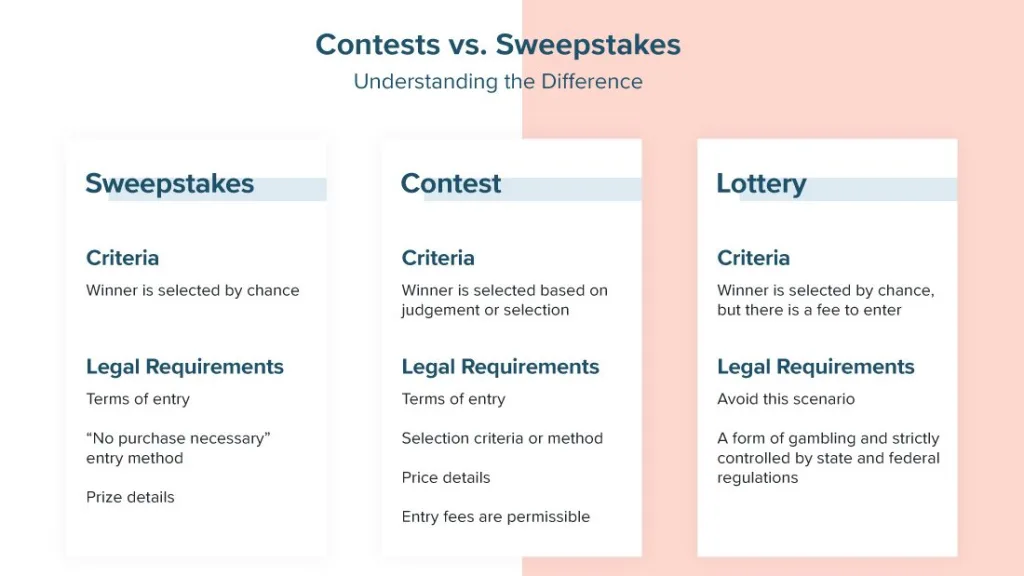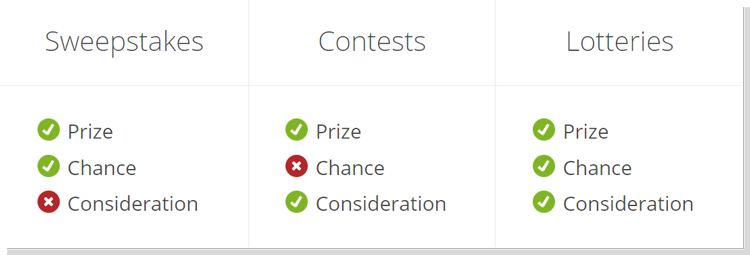Choosing the right promotional strategy can make or break your audience engagement efforts. Businesses and individuals often use prize-based campaigns to boost visibility, but misunderstanding the rules behind these methods carries real risks. Legal compliance, audience expectations, and campaign goals all depend on selecting the appropriate format.
Prize-driven promotions fall into three main categories. Each has distinct entry requirements, legal frameworks, and marketing applications. For example, some formats require skill-based participation, while others rely purely on chance. Mixing these elements incorrectly could lead to fines or wasted resources.
This guide clarifies how to align your goals with the right promotional tool. We’ll explore registration laws, entry mechanics, and strategies to maximize participation. Whether you’re launching a product or building brand loyalty, knowing these critical distinctions ensures your campaign stays effective and lawful.
Key Takeaways
- Legal requirements vary significantly between promotional types
- Skill-based formats engage audiences differently than chance-based ones
- Registration thresholds exist for certain campaigns in most states
- Entry methods impact participant demographics and behavior
- Tax implications differ based on prize value and campaign structure
Introduction to Sweepstakes, Contests, and Lotteries
Three distinct engagement models dominate modern promotional campaigns. Each format attracts participants through unique mechanics while addressing different marketing objectives. Understanding their core differences helps businesses select tools that align with legal standards and audience expectations.
Defining Sweepstakes and Their Appeal
Sweepstakes operate on pure chance, requiring no special skills for entry. Winners get selected randomly from eligible participants, making these giveaways accessible to broad audiences. This simplicity drives high participation rates compared to other promotional types.
Popular examples include online draws where users submit contact details. Businesses favor sweepstakes for quick list-building and brand exposure. Legal compliance focuses on avoiding mandatory purchases – a critical distinction from regulated formats.
Understanding Contests and Lotteries
Contests demand demonstrated skill through creative submissions or problem-solving. Judges evaluate entries using predefined criteria, whether objective metrics or subjective opinions. Common formats range from photo competitions to recipe challenges.
| Feature | Sweepstakes | Contests | Lotteries |
|---|---|---|---|
| Entry Method | No purchase required | Skill-based submission | Payment typically needed |
| Winner Selection | Random draw | Judged evaluation | Random selection |
| Legal Requirements | No registration (usually) | Clear judging criteria | State licensing required |
Lotteries differ fundamentally as government-regulated gambling activities. These require monetary consideration (payment) and operate under strict oversight. Most states prohibit private lotteries, reserving them for authorized entities like charity organizations.
Sweepstakes vs Contests vs Lotteries: What's the Difference?
Understanding promotional formats requires recognizing their legal foundations and participant expectations. Let's dissect what makes each model unique – and why those nuances matter for compliance and engagement.

Key Characteristics of Each Promotion
Three core elements define these promotional tools:
- Selection method: Random draws vs judged evaluations
- Participation requirements: No barriers vs skill demonstrations
- Legal status: Generally permitted vs regulated gambling
| Entry Requirement | Winner Decision | Legal Status | |
|---|---|---|---|
| Promotion A | None | Random | Legal nationwide |
| Promotion B | Creative submission | Judged | Legal with clear rules |
| Promotion C | Payment required | Random | Mostly prohibited |
Common Misconceptions Explained
Many assume all giveaways follow the same rules. Reality check:
1. "Free entry" isn't optional – legitimate chance-based promotions must provide alternative entry methods without purchases.
2. Creative competitions can include limited random elements if skill remains the primary factor.
3. Nearly 40 states prohibit private operations combining payment, prizes, and chance – the exact definition of unauthorized gambling.
Navigating Legal Requirements and Official Rules
Compliance separates successful promotions from legal nightmares. Campaign organizers must master two critical concepts: eliminating prohibited entry barriers and fulfilling location-specific obligations.
Understanding Consideration and No Purchase Necessary
Consideration – a legal term for exchanging value – determines whether your promotion qualifies as a lawful giveaway. Monetary forms include purchases or entry fees. Non-monetary types involve excessive time investments like mandatory social media posts.
Remove consideration entirely to avoid lottery classification. Always provide free entry methods requiring minimal effort. Example: "Mail-in entries accepted without purchase" satisfies no purchase necessary rules while maintaining engagement.
State Registration and Bonding Requirements
Three states enforce special registration requirements:
- Florida/NY: Register if prizes exceed $5,000
- Rhode Island: $500 threshold for retail promotions
Florida and New York mandate bonds matching total prize values. This guarantees winners receive promised rewards. Sponsors must file paperwork 7-30 days before launch depending on state laws.
Digital campaigns face additional disclosure rules. Website terms and social posts must clearly explain entry methods, dates, and eligibility. Consult legal counsel when crossing state lines – non-compliance penalties often exceed $10,000.
Effective Entry Methods and Engagement Strategies
Maximizing participation while maintaining quality requires strategic entry methods. The right approach balances legal compliance with audience preferences, turning casual participants into loyal brand advocates.
Entry Techniques: Single Opt In vs Double Opt In
Single Opt In (SOI) offers instant entry through one-step signups. This method generates high participation numbers quickly – ideal for time-sensitive campaigns. However, unverified emails might dilute your contact list quality.
Double Opt In (DOI) adds a confirmation layer via email. While reducing total entries by 20-40% according to recent studies, it ensures engaged participants. "DOI converts 3x better than SOI in long-term marketing," notes a digital strategy report.
Leveraging Social Media and Mobile Platforms
Mobile-first strategies thrive through text-to-enter systems. Always disclose costs clearly: "Msg & data rates may apply" keeps campaigns compliant. Platforms like Twitch and Discord reward interactive formats:
- YouTube: Comment-driven entries boost video engagement
- Twitter: Retweet campaigns amplify brand reach
- Twitch: Live-stream giveaways build real-time connections
Each platform demands unique rules analysis. Instagram requires specific hashtag disclosures, while TikTok bans certain prize structures. Align your approach with both platform guidelines and audience behavior patterns.
Best Practices for Planning Your Promotion
Successful campaigns demand ironclad documentation. Your terms and conditions act as both participant guides and legal safeguards. Make sure every detail aligns with state laws and campaign goals before launch.
Crafting Clear Terms and Conditions
Official rules become binding contracts the moment your promotion starts. These documents must include 11 non-negotiable elements:
- Explicit "no purchase necessary" statements
- Exact start/end dates in local time zones
- Age and residency requirements
- Free entry alternatives matching paid options
Make sure prize descriptions specify retail values and delivery timelines. Notification procedures should outline response deadlines for winners. Contest rules often fail when using vague phrases like "subject to availability" without clear backup plans.
Include sponsor contact details and void jurisdictions upfront. A 2023 legal study found 58% of promotional disputes stem from incomplete eligibility disclosures. Plain language prevents misunderstandings – avoid legalese that confuses participants.
Conclusion
Navigating promotional campaigns requires precision in both strategy and compliance. Sweepstakes thrive on random selection, while contests reward skill – critical differences that shape audience engagement and legal obligations. Lotteries remain high-risk options due to strict gambling regulations.
Maintain winner records for four years post-campaign. Bonded promotions in Florida and New York require submitting detailed lists. Always verify state-specific laws regarding prize limits and age restrictions before launch.
Effective giveaways balance excitement with transparency. Avoid mandatory purchases and clearly outline entry methods. Use bulletproof terms and conditions addressing potential disputes – incomplete rules cause 58% of legal challenges.
Choose formats aligning with your goals: chance-based entries for quick reach, skill-driven activities for targeted engagement. Consult legal experts when crossing state lines or offering high-value prizes. Thorough planning prevents costly revisions and builds trust with participants.

